Understanding the Different Types of Cabinet Hardware
In your endeavour to perfect your new kitchen, the hardware you decide to incorporate can make a phenomenal difference.
These finishing touches on your kitchen cabinets include an array of options like pull handles, finger pulls, standard pulls, edge pulls, appliance pulls, bar pulls, and cup pulls, and knobs. The choice could certainly be overwhelming, but here's a handy guide to get you started.
- Pull Handles: Designed for heavy-duty uses, these are perfect for larger cabinets such as upper cabinets and lower cabinets where greater grip strength is required.
- Finger Pulls: These are minimalist, sleek, and suitable for modern kitchens. They're great for smaller cabinets and drawer fronts where space is key.
- Standard Pulls: The perfect all-rounder, these fit just about any cabinet size and style, and offer a good mix of visual appeal and functionality.
- Edge Profile Handles: Tucked away on the edge of the door panel or bottom of the door, these trendy pulls offer a clean, uncluttered look.
- Appliance Pulls: As the name suggests, these are designed to blend in seamlessly with your appliances, neat for integrated kitchens.
- Bar Pulls: These long, straight pulls offer a modern look and are practical for large base cabinets.
- Cup Pulls: The quaint, traditional style works well on the drawer front and offers easy accessibility.
The placement of these elements is fundamental to a functional kitchen. Whether it's about the placement of knobs or the right spot for cabinet pulls, the idea is to ensure comfort and accessibility alongside aesthetic appeal.
Measurements matter, so using a tape measure is indispensable. A cabinet hardware jig could also prove to be a great aide. But more of that later.
Let's dive into the specifics of placement now - where exactly should your cabinet hardware go on your cabinet doors? Tune in to the next section!
Choosing the Right Cabinet Hardware for Your Kitchen
If you've moved into a new kitchen, or your existing setup screams for a revamp, selecting the correct kitchen cabinet handles to complement the kitchen cabinets can elevate your kitchen design aesthetic, ensuring a functional kitchen that speaks of sophistication.

Verdano Graphite Matt Kitchen with white worktops and Bar Handles
Of utmost importance is the cabinet hardware placement, influencing both visual appeal and utility. There's a wealth of options when it comes to cabinet hardware from cabinet pulls, bar pulls, cup pulls, finger pulls, and appliance pulls to drawer pulls and edge pulls.
Elements such as placement of knobs on your upper cabinets and lower cabinets, or the positioning of pulls on the drawer front, can either enhance or hinder the overall flow of your kitchen.
You may wonder, 'Where exactly should these go? At the top of the door, or the bottom? The centre or towards the edge?'. Allocate a substantial amount of consideration towards the cabinet hardware jig, critical for exact placement.
- Upper and Wall Cabinets: When dealing with upper cabinets or wall cabinets, it's common to place the knob or the pull handle towards the bottom corner of the door.
- Base and Lower Cabinets: For base cabinets and bottom cabinets, placement towards the top of the cabinet door, generally works best. The door panel's top edge or the bottom corner of the door is ideal.
- Drawer Handles: Handle pull placement tends to be easier on drawers as the centre of the drawer is most often the desired location, again depending on the size and style.
Remember, the key to a well-balanced kitchen lies in aligning the style, scale and placement of the cabinet hardware with the overall aesthetics and functionality of the kitchen.
It's not all about the aesthetics, though - maintaining functionality is imperative. Heavily used cabinets benefit from standard pulls, while lesser-used, smaller cabinets or those at height might be better suited to knobs. Consider the size of your cabinets too - large pulls may dwarf smaller cabinets, and small knobs may look incongruous on large cabinets.
Your choice of new hardware should reflect both the style and size of the cabinet but remember that very small or very large cabinets might require custom placement, so a tape measure will be instrumental for pinpoint precision.
Ultimately, cabinetry hardware adds the final touch to your kitchen. So, whether it's refreshing your new kitchen or revamping your existing one, correct hardware placement can truly transform your kitchen experience.
Factors to Consider When Placing Cabinet Handles, Knobs & Pulls
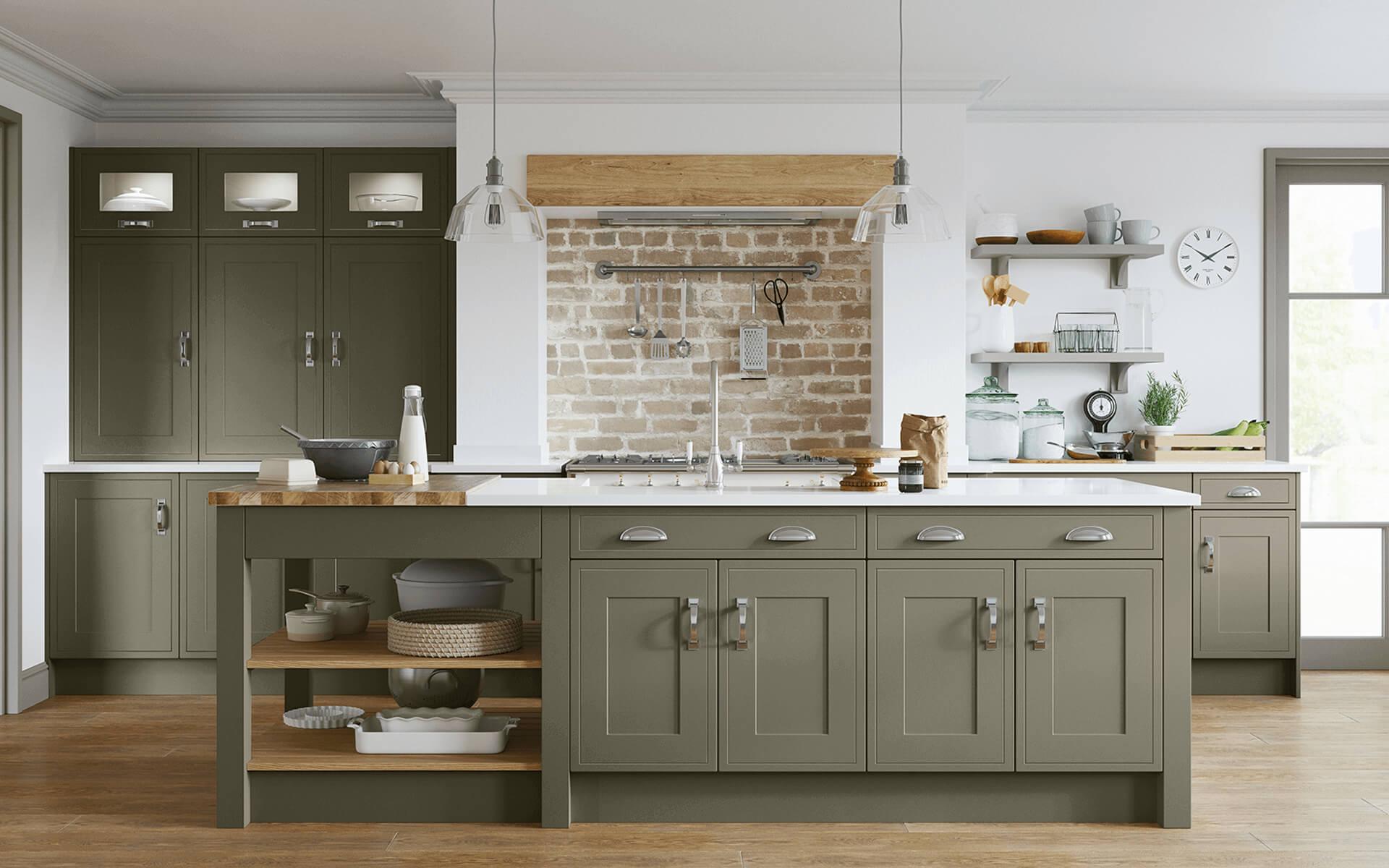
Dewsbury Reed Green kitchens with D Handles and Cup Pull Handles
Installing new hardware in your kitchen can give it an instant makeover. Cabinet doors, drawer fronts, and various types of kitchen cabinets – upper cabinets, wall cabinets, base cabinets, and lower cabinets – can all be revitalised with new cabinet hardware.
But, before that, you need to understand some factors to figure out the exact placement for knobs, pulls, and handles.
- Size of Your Cabinets: The size of your cabinets will largely determine the placement of knobs. Smaller cabinets, for instance, will require different placement of knobs or pulls compared to large cabinets. The placement for kitchen cabinet knobs will differ from appliance pulls. If you're unsure about the size of your cabinets, you can use a tape measure to take the measurements. Don’t forget to consider the bottom edge of the door and the top of the cabinet door too.
- Type of cabinet hardware: Assessing your current cabinet hardware can provide a roadmap for your new kitchen hardware setup. Do you currently use standard pulls, cup pulls, edge pulls, or bar pulls? Knowing what type of pull handles or drawer pulls you have can contribute towards deciding new hardware with the same dimensions for a hassle-free change.
- New Cabinet Hardware: Ensure that the new cabinet hardware aligns with the rest of your kitchen's style and functionality. When moving on from old to new cabinet hardware, don't compromise on aesthetics. Whether it's new handles, pull handles, or drawer handles, choose ones that complement your kitchen's design. For a functional kitchen, make certain that your new hardware also aids in easy door and drawer operation and doesn't interfere with other appliances and attributes of your kitchen.
- Placement Consideration: Proper cabinet knob placement is crucial. Whether it be the top of the door, bottom of the door, centre of the drawer, or bottom of the cabinet, precision in placement can assist in a seamless operation. For the exact placement, you may choose to employ a cabinet hardware jig, an inexpensive tool designed to ensure alignment and accuracy in placement.
Optimal Placement for Cabinet Knobs on Upper Cabinets
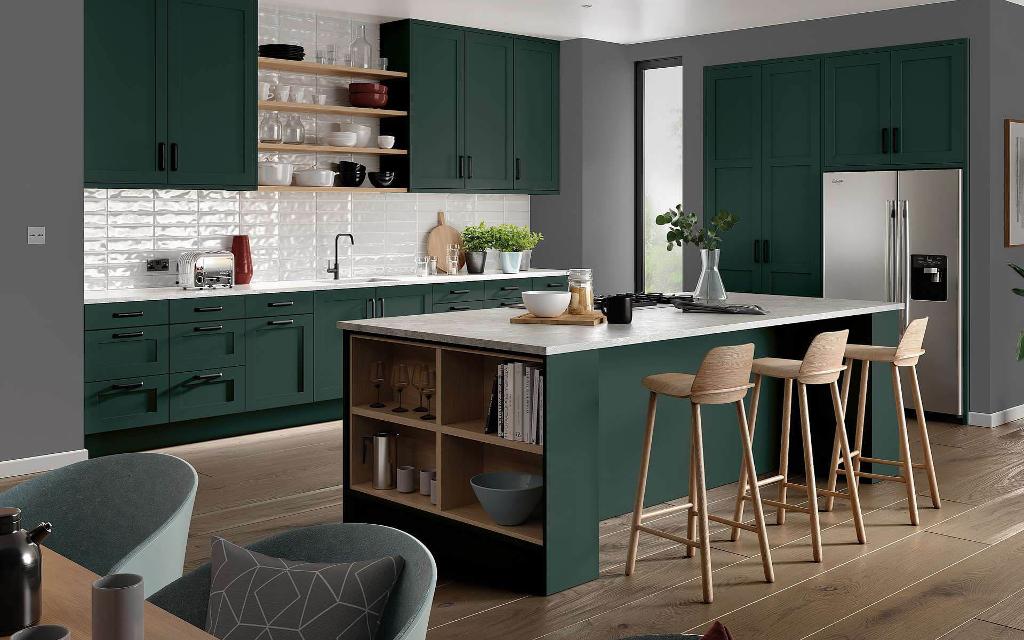
Tenby Heritage Green kitchen with D Handles and Base and Upper Units
When it comes to upper cabinets, the optimal placement of kitchen cabinet knobs and pulls can make a world of difference to not only the aesthetics of your new kitchen but also its functionality.
The ease of accessing your upper cabinets adds to the functional kitchen.
For upper cabinets, placement of knobs commonly happens on the bottom corner of the door. The bottom of the door or the bottom edge of the door is considered the most accessible position when reaching for items, especially in high spaces.
Opting to place knobs, pulls, or cabinet hardware such as bar pulls and hamper pulls here fits in naturally with the motion of opening a cabinet door, making everyday kitchen tasks more convenient and less strenuous.
But remember, with all the different cabinets you may have including smaller cabinets or large cabinets, the exact placement really depends on the size of your cabinets.
Here's a golden tip: If you're not sure about the placement, make a rough estimate by dividing the door panel into four, placing the knob on the edge of the topmost quadrant. And don't forget to keep a tape measure at hand!
Proper Placement of Drawer Pulls on Smaller Cabinets
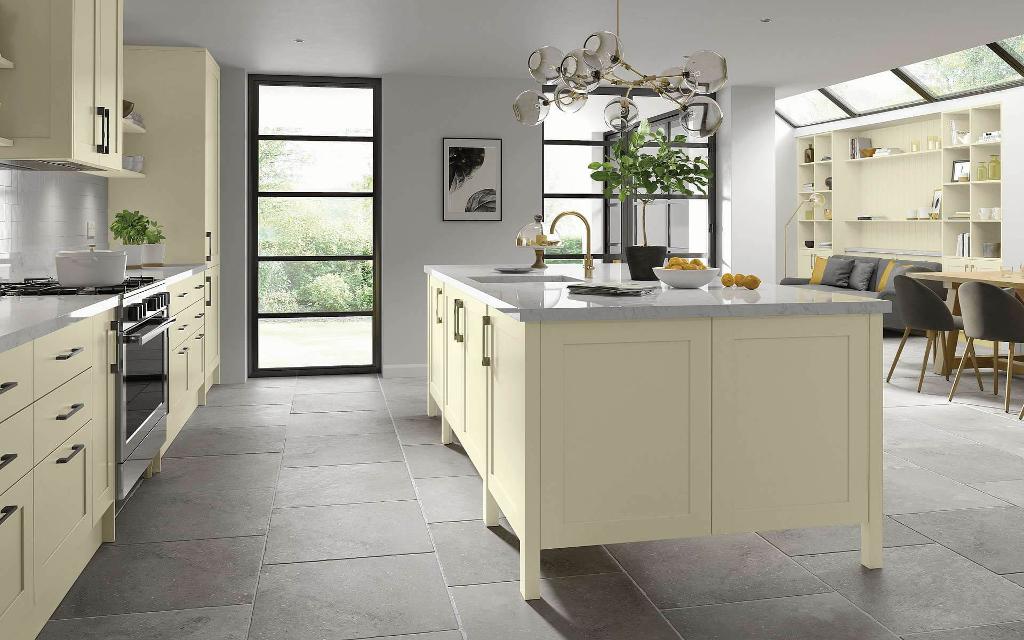
Millwood Mussel Kitchen showing correct alignment of Handles and Pulls
Smaller cabinets can accentuate and enhance the overall aesthetic of your kitchen while also providing functional storage. However, placing drawer pulls on them requires precision and a keen eye for proportions.
When it comes to the cabinet hardware placement of smaller cabinets, there are a few factors to consider.
Remember, the guide here can be used across new kitchens, with new cabinets or for updating your existing kitchen with new handles.
First, the placement of knobs and pulls on smaller cabinets should align with the size of your cabinets for functionality and aesthetics.
This means the smaller the cabinet, the smaller the size of the cabinet handle or knob should be. The standard pulls, cup pulls, and appliance pulls will be too large and overwhelming for smaller cabinets.
Hence, consider finger pulls, bar pulls, or smaller pull handles for such cabinets.
For a smaller cabinet with one or two drawers, the pull or knob should be centred on the drawer front. To make out the exact placement, you should measure the centre of the drawer from side to side using a tape measure.
But remember, if the drawer is longer than 50 centimetres (19 inches), consider placing two knobs or pulls instead of one.
| Hardware Type | Size of Cabinet | Placement |
|---|---|---|
| Finger pulls, bar pulls | Smaller cabinets | centre of the drawer front |
| Standard pulls, appliance pulls | Large cabinets | top of the cabinet door and bottom of the door |
In the case of cabinets with doors, place the knob or pull on the edge of the door panel. The pull or knob should be 2.5 - 5 centimetres (1 - 2 inches) up from the bottom of the door for base or bottom cabinets.
For wall cabinets, the placement should be 2.5 - 5 centimetres (1 - 2 inches) down from the top of the door.
Finally, while you're caught up in proper cabinet knob placement, don't forget to consider the finish and style of the new cabinet hardware to make sure it blends with the overall design of your kitchen.
When you are fitting your kitchen cabinet knobs or handles using the above guidelines, remember the adage, "Measure twice, cut once". Utilise a cabinet hardware jig to ensure you get the correct, level placement the first time around.
Now that you are thoroughly equipped with understanding the placement of these smaller but crucial components in your kitchen, you're ready to take that plunge into para-functional kitchen space. Happy fitting!
Tips for Installing Cabinet Handles on Lower Cabinets
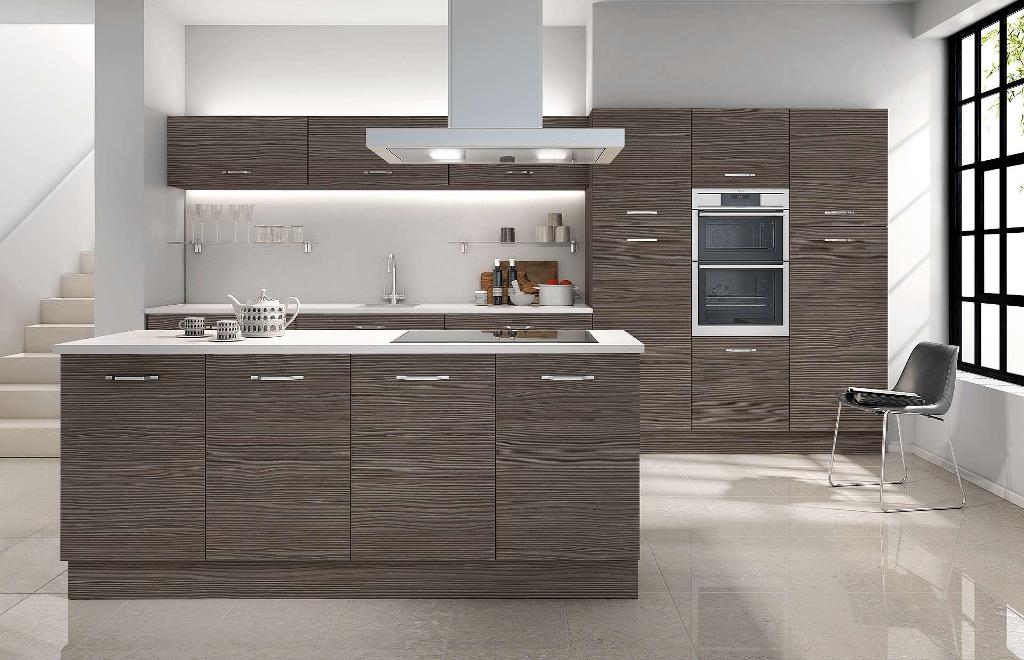
Metro Brown Grey Avola Modern Kitchen with linear positioning of lower base units handles
Lower cabinets, commonly referred to as base cabinets, pose a slightly different challenge when it comes to new hardware installation given their placement in the kitchen.
A dynamic working environment, your kitchen cabinets should not only infuse style into your kitchen décor, but also contribute to a functional kitchen.
With the right placement of knobs and pull handles, using your kitchen should be a seamless and comfortable experience.
Gauging the Right Position for Cabinet Hardware on Lower Cabinets
The exact placement of your cabinet hardware on lower cabinets can significantly influence the overall aesthetic of your kitchen.
The most common guideline dictates installing the knob or pull on the top corner of the door panel, specifically where the door rail (horizontal part) meets the door stile (vertical part).
This results in the pull being positioned at an angle. For a more modern approach, consider positioning the knob or pull horizontally on the top rail.
Cabinet Size and Hardware Placement
Believe it or not, the size of your cabinets can dictate the new cabinet hardware placement. For larger cabinets, it's a good idea to use larger, standard pulls or even appliance pulls.
Smaller cabinets often look best with small knobs or bar pulls. As a general rule of thumb, the bigger the door panel, the bigger the knob or pull handle. To estimate the size, you can simply use a tape measure to find the size of the cabinet door.
Flawless Placement with a Cabinet Hardware Jig
Want to ensure that your new handles are perfectly aligned? Use a cabinet hardware jig! This ingenious little device eliminates guesswork, ensuring that your cabinet hardware is positioned where you want it, time after time.
This is especially important if you have several lower cabinets. The hardware jig will speed up the process while ensuring your pulls and knobs are aligned in height and width across different cabinets.
Making the Most of Cabinet Door Design
Finally, it's important to remember the bottom of the door when installing new cabinet hardware.
For example, if you have a door with a large bottom edge, installing bar pulls, finger pulls, or edge pulls on the bottom edge of the door can create a unique and aesthetically pleasing look.
Most importantly, it's your kitchen! Don't be afraid to experiment a bit with your placement and find the position that works best for you.
Creating a Cohesive Look with Cabinet Hardware Placement
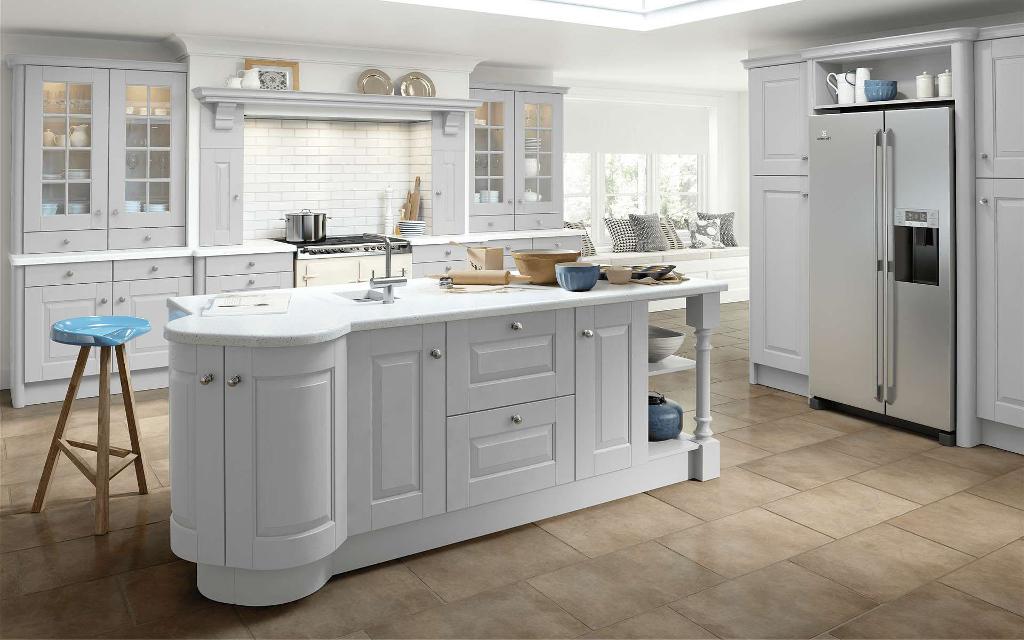
Fleetwood Light Grey with Chrome Knobs on both base and wall units create a unifying look
Thinking of remodelling your kitchen? If so, you've probably pondered long and hard over the aesthetic features: the colour schemes, worktop materials, whether to add a trendy island - oh, and let's not forget the ever-debated topic of 'where to put handles, knobs, and pulls on kitchen cabinets'.
Such a trivial task might seem low down on your list of priorities, but it's crucial for your newly tailored kitchen to function smoothly. Let's dive into the detail.
Envisioning Your New Kitchen
When imagining your new kitchen, a tangle of terms might whirl around your mind: upper and lower cabinets, wall cabinets, base cabinets - heck, even drawer fronts and door panels.
But don't worry, you're not alone. We all get lost down that tumultuous jargon trail.
As arduous as it may seem, your first step should revolve around understanding your cabinetry's anatomy. What's the difference between wall and base cabinets?
How does a 'lower cabinet' differ from the 'bottom of the cabinet'? Clear the fog by mentally categorising your kitchen's diverse structures into easily identifiable segments.
Tackling Cabinet Hardware Placement
The key to successful cabinet hardware placement lies in precision. Whether it's edge pulls, finger pulls, bar pulls, standard, cup, or appliance pulls, your choice of hardware must match your cabinets like a well-fitting glove.
So grab a tape measure and dust off that calculator. It's time to get meticulous with measurements - and guesswork has no place here.
You've got the width, height, and depth of your cabinets recorded? Splendid! Now, this next part might be a tad tedious, but it's important.
You must gauge the size of your cabinets yet again, albeit this time from a different perspective. Consider the proportions of your cabinet doors.
Measure the distance between the top of the door and the bottom, also measure the length of the door panel, and don't forget the bottom edge of the door.
And please, don't neglect the small print - the bottom screw of your new cabinet hardware can make a world of difference.
New Hardware: A Fresh Start or a Painful Puzzle?
There's no denying it: introducing new hardware into your kitchen can feel both exciting and overwhelming. But remember, a blend of patience and understanding will pave the way for a functional kitchen that's not just a pretty face.
Let's talk size: size of your cabinets, size of the cabinet hardware, and the exact placement. And it's not just the size that matters, but the type of cabinet that the hardware is being installed on.
Kitchen cabinet handles may sit wonderfully on large cabinets, but might overpower smaller cabinets. On the other hand, kitchen cabinet knobs might seem too petite on your impressively sized lower cabinets.
Your freshly purchased pull handles may get lost on your wall cabinets or look clumsy on your base cabinets.
Consider the long-term: where are you likely to grab when opening the various cabinets? At the top of the cabinet door? The bottom corner of the door? The centre of the drawer?
Yes, placing your new kitchen hardware requires much deliberation. But meticulously planning the cabinet hardware placement will ensure a practical, user-friendly, and aesthetically pleasing kitchen.
After all, wouldn't you agree that such a significant investment deserves your absolute attention?
And remember, like all major renewal projects, it's not always a sprint; sometimes, it's a marathon. Patience is crucial. After all, Rome wasn't built in a day, nor will your perfect kitchen be.
Measuring and Marking: A Guide to Accurate Placement
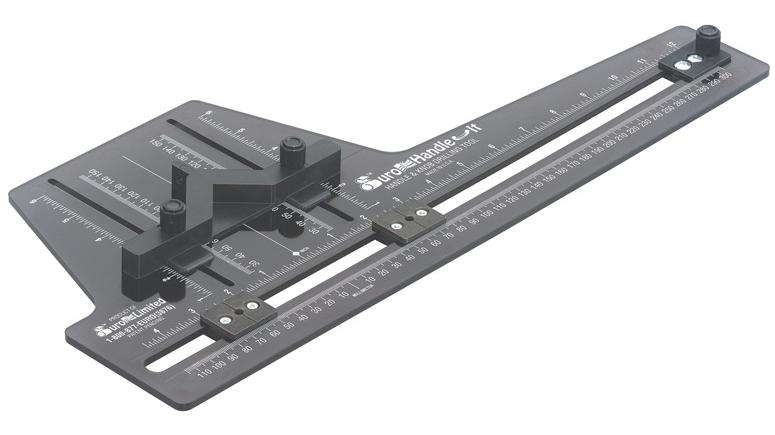
Handle Position Marking Installation Tool
Getting placement just right for your kitchen cabinet handles and pull handles, whether they are cabinet pulls, cup pulls, finger pulls, bar pulls or appliance pulls, requires a keen eye and a few important tools.
Your most trusted buddy here will be your tape measure. Measuring precisely is a crucial step to ensure that all of your kitchen hardware is level and lines up correctly, whether they're being fitted to upper cabinets, lower cabinets, wall cabinets, or base cabinets.
The measurement process can sometimes seem daunting, especially if you're working with a new kitchen or fitting pull handles onto new cabinets.
The fear of damaging your fresh new panels can add to the woes. But remember, it might seem like a giant mountain to climb, but with accurate measurements, you're halfway up that mountain already.
Measure twice, cut once - It's an old saying but it holds true especially when it comes to cabinet hardware placement.
Here's a step-by-step guide to making your measurements:
- Use your tape measure to find the centre of the drawer front or door panel from side to side, and mark it lightly with a pencil.
- For drawers, the pull or cabinet knob should be placed at the centre of the drawer, both top to bottom and side to side. The exact placement might depend on the size of your cabinets or drawers, or on your personal preference.
- For cabinet doors, the most common placement for kitchen cabinet knobs is 2.5 to 7.5 cm (1 to 3 inches) from the bottom corner of the door, or for pulls, the top of the door handle in line with the bottom screw on the top hinge.
- If using multiple knobs on a wider drawer, divide the drawer into thirds or quarters and place the knobs in the centre of those divisions.
A Few Watchpoints:
- If you have large cabinets, the handle pull might be located at the top of the door or drawer front, and centred on the door stile.
- In smaller cabinets, it's common to keep the edge pulls placed on the bottom edge of the door or at the top of the door.
When the marking is complete, you are ready to drill! Remember, your cabinet hardware jig can be a lifesaver for perfect alignments and to prevent any unwanted damage when drilling.
Choosing Between Cabinet Knobs and Pulls

St Ives Marine with White Worktops and Round Oak Knobs
As you embark on the journey of refreshing your kitchen cabinet hardware, you'll quickly realise that for every cabinet drawer, door, and panel, there's a vast array of hardware options to match.
From the modern feel of bar pulls, the rustic charm of cup pulls, or the versatile functionality of finger pulls, your choice can significantly imbue your kitchen cabinets with your unique design aesthetics.
At first glance, you might be forgiven for mistaking the selection process as merely a decision between style (if we're being fancy, we talk of 'appliance pulls') and functionality ('pull handles', so straight to the point!).
However, the hardware world is filled with cross-hybrid marvels that marry both these elements providing you with a design pickle.
Cabinet Knobs: Where Simplicity Meets Versatility
Simple but effective, cabinet knobs often enhance the aesthetic of your cabinets without overpowering their beauty.
Known for their round shape and smooth surface, kitchen cabinet knobs can be perfect for upper cabinets where easy reach is paramount.
They offer just the right amount of grip and are relatively easy to position and install, especially for smaller cabinets. The placement of knobs is typically at the corner of the door panel, to ensure a convenient grasp.
Pulls: Putting Function First
Embodying a larger, elongated form compared to knobs, pulls, especially drawer pulls, are a match made in heaven for larger cabinets and drawers due to their easy-grip functionality.
Pulls often fit perfectly onto the cabinet door or drawer front, providing more space for grasp. They come in diverse types, including standard pulls, bar pulls, edge pulls, and cup pulls, each unique in offering varied levels of comfort, usability, and aesthetic ambiance.
Booking Your Spot: Determining Exact Placement
Pull, knob, or a blend – once you've made the decision, the next part of your cabinetry journey involves the exact placement of your new hardware.
It's often that functional kitchen demands pull handles be placed on the bottom edge of the door or drawer for lower cabinets, while knobs rest on top of the cabinet door for upper cabinets.
However, take the time to experiment, perhaps using a cabinet hardware jig, your tape measure and some painter's tape to simulate different hardware placements.
Fabulous kitchen hardware is just another punctuation in the story of your home, but never underestimate the power of well-placed punctuation marks!
As you move through this part of your new kitchen journey, remember that while knobs and pulls differ in many aspects, either can breathe new life into your kitchen space when used correctly.
Ready to start?
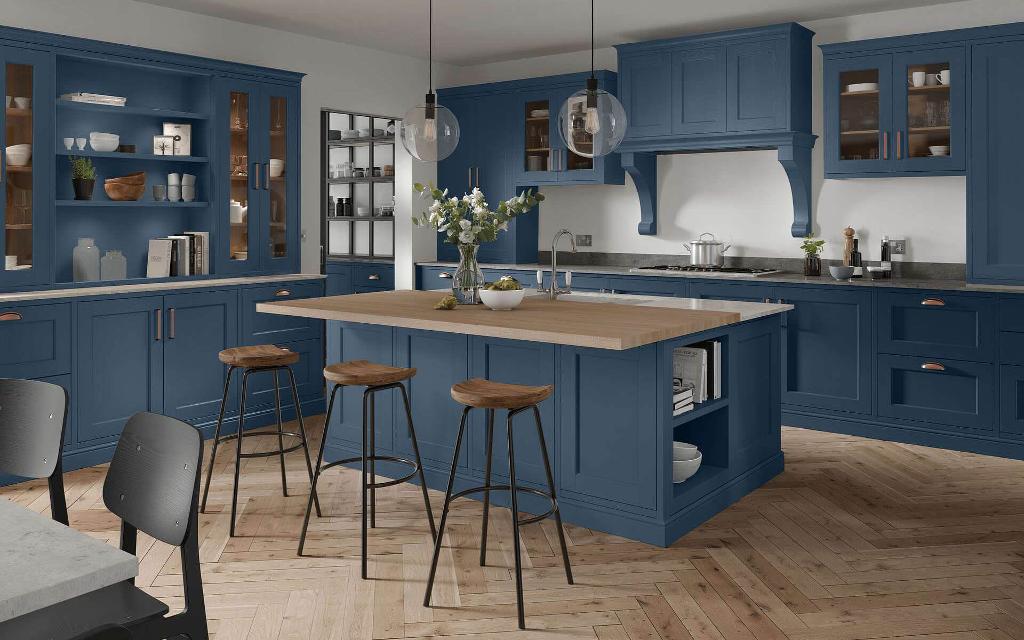
Portwood Eiffel Blue Shaker Kitchen with Cup Handles and D Pull Handles
Undeniably, modernising your kitchen cabinets through deftly placed cabinet handles, knobs, and pulls can be a game-changer.
You've probably grappled with arduous decisions like the size of your cabinets, placement of knobs, and even the style of cabinet doors. Let's take a moment to acknowledge the exactitude and precision it demands. Well done, you!
Remember, every kitchen is unique and so are your habitudes. Whether it's upper cabinets with bar pulls or lower cabinets with finger pulls, what matters is your comfort and the functionality of your kitchen.
Take it slow, one cabinet door at a time. Though a cabinet hardware jig could become your best friend in achieving a seamless alignment across all cabinets!
By now, you're equipped to create the most functional and aesthetically pleasing kitchen, making the process of implementing your new kitchen design a delight rather than a conundrum.
Your new cabinets are eager to be adorned with new handles. So, why wait?
Embrace this fresh start, bring in the tape measure, start plotting the bottom screws, open that pack of new hardware. Let your kitchen flourish with your infusion of flair.
Ready, Set, Go! Transform those kitchen cabinets, your morning coffee rituals will thank you. After all, the kitchen is the heart of the home, so let's rejuvenate its pulse!
Should you have any reservations or queries, feel free to ask. We're here to accompany you through this make-over journey.
For further advice and support on cabinet hardware placement or cabinetry hardware selections, kindly reach out to our adept team.
It's time to design a kitchen that echoes your lifestyle and charisma. Unleash your creativity, the perfect kitchen is just a few tweaks away!
Thinking of starting your own kitchen project, talk to the Better team for help and advice!
